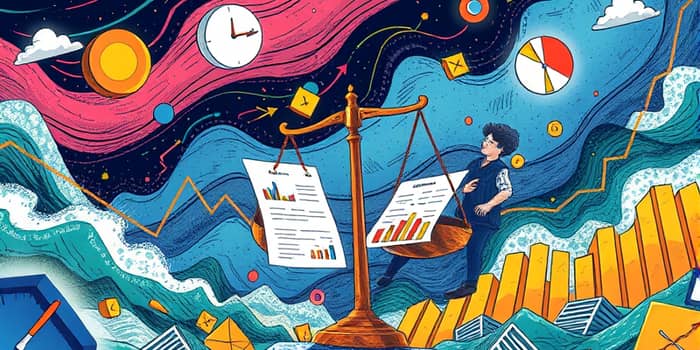Economic downturns can strain budgets and force difficult decisions. Understanding how personal loans behave when the economy falters is essential for making informed choices and maintaining financial stability.
Historical Trends of Personal Loans
Throughout past recessions, the personal loan market has displayed marked shifts in consumer borrowing habits. During the Great Recession, reliance on payday lending increased, as many households turned to high-cost credit when traditional lending standards tightened.
By contrast, the 2020 pandemic recession saw a surprising decline in payday borrowing in regions like California, driven by government assistance programs that provided direct relief. Overall personal loan balances fell 7.6% in 2020—the first drop since 2011—only to rebound with a 15.2% surge in 2021.
Current Personal Loan Market Statistics
As of the end of 2024, personal loan portfolios reflect both caution and resilience. Average debt per borrower stands at $11,607, down slightly from $11,773 in late 2023. Meanwhile, interest rates have climbed, making every percentage point significant for consumers.
- Average personal loan interest rate: 12.36%
- Boomers’ average balance: $20,370 (highest among generations)
- Average APR on new credit cards: 24.20% (March 2025)
These figures suggest personal loans can still offer more predictable repayment terms compared to variable-rate credit cards, especially for borrowers with strong credit profiles.
Economic Factors Affecting Personal Loan Rates
Interest rates on personal loans are influenced by a mix of market forces and central bank policies. The Federal Reserve’s decisions reverberate through lending markets, affecting both fixed- and variable-rate products.
After cutting rates twice in late 2024, the Fed is expected to enact only two more reductions in 2025. This means borrowing during economic uncertainty will come at rates that remain historically moderate, though not necessarily record lows.
Consumer Usage Patterns
A survey of recent lending activity reveals that about half of borrowers pursue personal loans to manage existing obligations rather than fund new purchases.
- Debt consolidation: 38.5%
- Refinancing credit card debt: 11.4%
- Everyday bills and expenses: 10.0%
- Home improvements: 6.5%
Between Q3 2024 and the end of the year, American household debt climbed by $3.8 trillion since pre-recession 2019 levels, with credit card, auto, student, mortgage, and HELOC balances all rising.
Alternative High-Cost Lending: Payday Loans
When traditional credit becomes scarce, some consumers resort to payday loans—short-term, high-interest products that can spiral into serious financial distress.
- Available in 32 states; banned elsewhere
- Triple-digit APRs with automatic repayment
- No credit checks required
Research demonstrates that government assistance programs can dramatically reduce demand for these predatory products by addressing the root cause: urgent cash shortfalls.
Credit Score Impact on Personal Loan Terms
Your credit score remains one of the strongest determinants of loan affordability. Borrowers scoring 680 and above often secure APRs that compete favorably with credit cards, while subprime applicants face much steeper rates if they qualify at all.
As a financial analyst recently observed, rates will be slightly lower, all else being equal, for those with good credit. This underscores the importance of maintaining a strong history of on-time payments and low utilization.
Strategic Considerations for Consumers
When contemplating a personal loan during a downturn, start with clear goals. Determine whether you are consolidating high-cost debt, financing necessary expenses, or seeking a safety net for unexpected bills.
Opting for a fixed-rate product can shield you from future rate hikes, as fixed-rate personal loans provide stability when markets swing. Conversely, variable-rate loans may look attractive initially but can become expensive if the Fed raises rates again.
Above all, conduct careful calculation of interest costs over the life of the loan. Use online calculators, factor in origination fees, and compare multiple lenders to secure the best deal. In times of economic stress, the right loan can be a bridge to recovery rather than a burden.
By understanding historical trends, current market conditions, and your own financial profile, you can navigate downturns with confidence. Informed borrowing is not only a practical tool—it is a powerful step toward long-term financial resilience.
References
- https://www.lendingtree.com/personal/personal-loans-statistics/
- https://www.investopedia.com/if-the-economy-struggles-will-people-turn-to-payday-lenders-the-answer-is-surprising-11740285
- https://www.bankrate.com/loans/personal-loans/interest-rate-statistics/
- https://www.statista.com/topics/9883/bank-lending-during-recessions/
- https://fred.stlouisfed.org/series/TERMCBPER24NS
- https://www.bankrate.com/loans/personal-loans/personal-loan-rates-forecast/
- https://www.investopedia.com/terms/p/personalfinance.asp
- https://newsroom.transunion.com/financial-crisis--10-years-later-consumer-credit-market-on-an-upward-curve/










